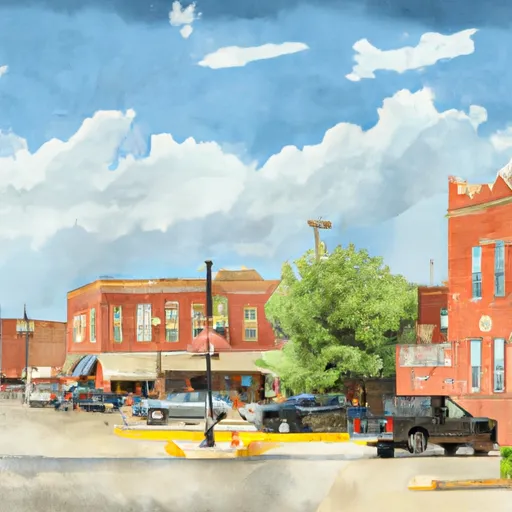-
 Snoflo Premium
Snoflo Premium
Get unlimited access to all our content
With no Ad interruptions! - Start Your Free Trial Login with existing account
Mc-Cook
Eden Index
Climate
7.6
•
Recreation
3.4
•
Community
2.4
•
Safeguard
4.8/10

McCook, Nebraska is a charming city located in Red Willow County, within the southwestern region of the state. It experiences a humid continental climate, characterized by four distinct seasons. Summers in McCook are typically warm with temperatures ranging from the mid-80s to low 90s Fahrenheit, providing plenty of opportunities for outdoor activities like hiking, biking, and camping. Winters, on the other hand, are cold and can occasionally be harsh, with temperatures dropping to the 20s and 30s. McCook receives an average annual precipitation of around 20 inches, with the majority of rainfall occurring during the summer months.
Hydrologically, McCook is situated in the Republican River watershed, which adds to the beauty of the area. The river provides opportunities for fishing, boating, and other water-based activities. Additionally, there are several lakes and reservoirs nearby, including Red Willow Reservoir and Medicine Creek Reservoir, which offer further outdoor recreation opportunities such as swimming, water skiing, and picnicking.
Overall, McCook, Nebraska provides a diverse range of outdoor recreation opportunities throughout the year, allowing residents and visitors to enjoy the natural beauty and scenic landscapes of the region.
What is the Eden Index?
The Snoflo Eden Index serves as a comprehensive rating system for regions, evaluating their desirability through a holistic assessment of climate health, outdoor recreation opportunities, and natural disaster risk, acknowledging the profound impact of these factors on livability and well-being.
Climate Health Indicator (CHI): 7.6
Mc-Cook receives approximately
542mm of rain per year,
with humidity levels near 80%
and air temperatures averaging around
11°C.
Mc-Cook has a plant hardyness factor of
5, meaning
plants and agriculture in this region thrive during a short period during spring and early summer. Most
plants will die off during the colder winter months.
By considering the ideal temperature range, reliable water supplies, clean air, and stable seasonal rain or snowpacks, the Climate Health Indicator (CHI) underscores the significance of a healthy climate as the foundation for quality living.
A healthy climate is paramount for ensuring a high quality of life and livability in a region, fostering both physical well-being and environmental harmony. This can be characterized by ideal temperatures, reliable access to water supplies, clean air, and consistent seasonal rain or snowpacks.
Weather Forecast
Streamflow Conditions
Republican
Area Rivers
Republican
Snowpack Depths
Republican
Reservoir Storage Capacity
Republican
Groundwater Levels
Recreational Opportunity Index (ROI): 3.4
The Recreational Opportunity Index (ROI) recognizes the value of outdoor recreational options, such as parks, hiking trails, camping sites, and fishing spots, while acknowledging that climate plays a pivotal role in ensuring the comfort and consistency of these experiences.
Access to outdoor recreational opportunities, encompassing activities such as parks, hiking, camping, and fishing, is crucial for overall well-being, and the climate plays a pivotal role in enabling and enhancing these experiences, ensuring that individuals can engage in nature-based activities comfortably and consistently.
Camping Areas
| Campground | Campsites | Reservations | Toilets | Showers | Elevation |
|---|---|---|---|---|---|
| Red Willow Reservoir State Rec Area | 200 | 2,620 ft | |||
| Karrer Park | 14 | 2,483 ft | |||
| Sappa Park | 5 | 2,528 ft |
Catastrophe Safeguard Index (CSI):
The Catastrophe Safeguard Index (CSI) recognizes that natural disaster risk, encompassing floods, fires, hurricanes, and tornadoes, can drastically affect safety and the overall appeal of an area.
The level of natural disaster risk in a region significantly affects safety and the overall livability, with climate change amplifying these risks by potentially increasing the frequency and intensity of events like floods, fires, hurricanes, and tornadoes, thereby posing substantial challenges to community resilience and well-being.
Community Resilience Indicator (CRI): 2.4
The Community Resilience Indicator (CRI) recognizes that education, healthcare, and socioeconomics are crucial to the well-being of a region. The CRI acknowledges the profound impact of these elements on residents' overall quality of life. By evaluating educational resources, healthcare accessibility, and economic inclusivity, the index captures the essential aspects that contribute to a thriving community, fostering resident satisfaction, equity, and social cohesion.

